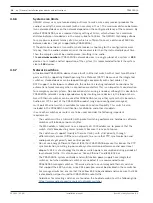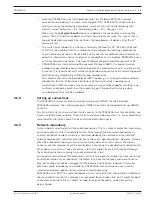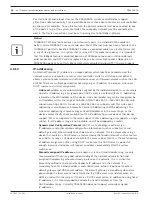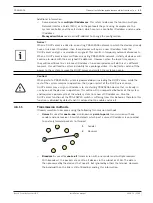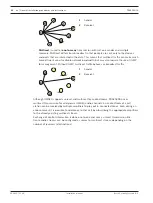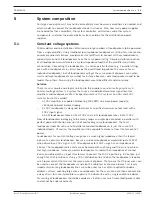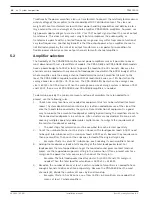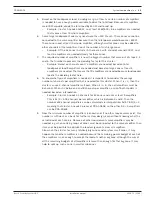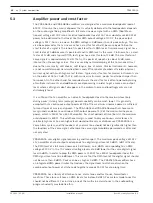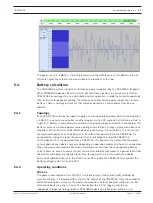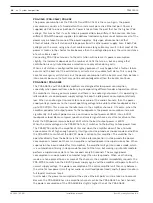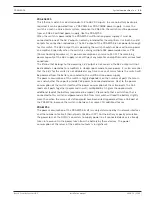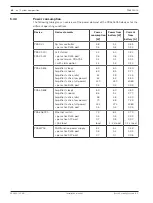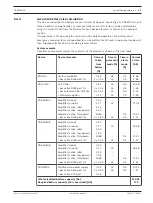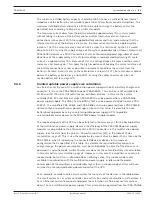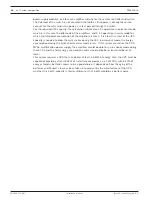
PRAESENSA
General installation procedures and instructions | en
29
Bosch Security Systems B.V.
Installation manual
2019.11 | V1.00 |
–
Because PRAESENSA uses the Rapid Spanning Tree Protocol (RSTP) for network
connection redundancy, the switch must support RSTP (IEEE
802.1D‑2004) with the
ability to change the following parameters, which must be set to the following (not
default) values: Hello_time = 9
s, Forwarding_delay = 30
s, Max_age = 22
s.
Make sure that
not more than 21
devices are between the root bridge and any other
device. The 22
nd
and further devices will not communicate anymore. This means that a
loop of 43 devices may work fine, but when the loop breaks, all devices after the 21
st
device are lost.
–
The switch must support the Link Layer Discovery Protocol (LLDP, IEEE
802.1AB) and
LLDP must be enabled. LLDP is a vendor-neutral configuration exchange protocol for
Layer 2 discovery based on the IEEE
802.1ab standard. This protocol allows a device to
advertise information such as its identity or capabilities to its neighbor. PRAESENSA uses
LLDP for network supervision. The Docent network diagnose tool also requires LLDP.
–
PRAESENSA uses Internet Group Management Protocol (IGMP), the communication
protocol responsible for communication between the end devices (hosts) and the switch
or router. It is used for dynamic multicasting between one source and a selected group of
destinations by establishing multicast group memberships.
For switches that offer the possibility of IGMP snooping, it is strongly recommended to
disable this feature. Performance limitations of the switch while snooping many
simultaneous IGMP messages may cause some messages to be dropped, resulting in no
multicast audio being present on the requesting port. Especially when using daisy-
chained devices this will be a problem.
4.6.8
Setting up connections
The PRAESENSA system controller manages all dynamic OMNEO channels between
PRAESENSA devices. The software program OMNEO Control is not needed to set up OMNEO
channels.
To set up static Dante channels from Dante sources to the PRAESENSA system controller, use
Dante Controller from Audinate. These static channels will be persistent, i.e. are automatically
restored after the Dante source has been switched off and on again.
4.6.9
Network redundancy
Dante supports so‑called glitch‑free audio redundancy. This is a failover protection mechanism
ensuring audio is resistant to network failure. To achieve glitch‑free audio redundancy an
entirely redundant network structure is required, doubling the network and the installed
network components, with dual Ethernet connections on separate subnets. However, to have
glitch‑free redundant audio, you cannot conveniently daisy‑chain units across the subnet.
Audio is sent and received on all the connections, eliminating the possibility of connections to
other devices in a chain. If one connection is lost, the audio stream is still received through
the second connection, meaning no audio information is lost.
An important restriction of this mechanism is that it only works for audio; the transmission of
control information is not redundant! Therefore, in the event of failover, audio continues to
play, but settings cannot be changed until the primary link has been repaired. This makes
glitch‑free audio redundancy unsuitable for PRAESENSA, that continuously uses control
information between devices for monitoring and call processing.
PRAESENSA uses RSTP to create redundancy. This is not glitch‑free, audio will be muted for a
short period of time until the network has recovered from a broken link, but it works for both
audio and control data. Also, it allows for loop‑through connections, so devices can be
daisy‑chained.
Summary of Contents for PRAESENSA
Page 1: ...PRAESENSA Public Address and Voice Alarm System en Installation manual ...
Page 2: ......
Page 193: ......














